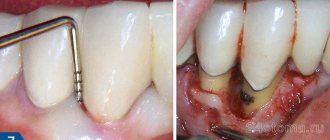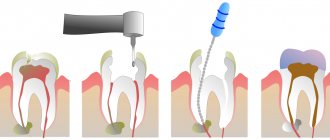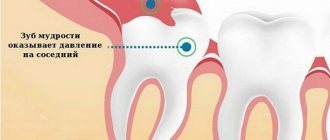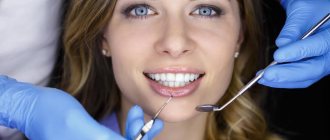Author of the article: Goldstein Maria Anatolyevna
Doctor-expert
Specialization: Dentist-therapist
Total work experience: since 2008
Reading time 7-8 minutes
CONTENTS:
- About tooth enamel
Compound
- Functions
- Diseases
- Why is tooth enamel damaged?
- Indications for strengthening tooth enamel
- How to restore tooth enamel in dentistry
Fluoridation
- Remineralization
- Implantation
- How to strengthen teeth enamel at home
Proper diet
- Folk remedies
- Special means
Enamel is the outer shell of the tooth, which bears the heaviest load (chewing). She is the first to take on the “blows” of active substances contained in food and drinks. In addition, every day, throughout a person’s life, it is the enamel that is subject to friction while chewing food. It is not surprising that over time the question may arise: how to strengthen tooth enamel and what will be required for this? To get a complete answer, you need to learn more about all the features and recovery options.
About tooth enamel
Research shows that enamel is the hardest tissue in the human body. It does not have the ability to regenerate, that is, after destruction it does not recover on its own. Most often, to solve problems with its destruction, the help of dentists is required, although effective resuscitation methods can be used at home.
Compound
The composition of tooth enamel includes the following substances:
- inorganic (96.5%): calcium phosphate;
- magnesium phosphate;
- calcium carbonate.
- water;
It is worth noting that the enamel of temporary (baby) teeth is less mineralized, so their thickness is half as large (they are more susceptible to caries).
Functions
Enamel covers the entire surface of the tooth crown and protects its hard part (dentin) from damaging factors. Within one crown, the thickness of the enamel word varies:
- thinner - on the cutting edges;
- thicker - on the tubercles of the occlusal surfaces (from the tops of the tubercles to the deep part of the fissure).
As long as the enamel performs its basic functions, a person does not feel discomfort when consuming hot/cold, as well as sweet drinks and food. The appearance of sensitivity to citrus fruits and other products indicates a clear problem with the enamel layer, which needs to be restored and/or strengthened.
You might be interested in:
Restoring tooth enamel
Veneers
Diseases
The most common diseases associated with enamel are:
- erosion;
- demineralization.
Despite the fact that only a few diseases can be identified, the consequences of their untimely treatment can be much greater.
Erosion
The main cause of erosion is:
- regular consumption of foods and drinks containing large amounts of sugar, caffeine and acid;
- bruxism (involuntary grinding of teeth at night);
- taking certain medications.
Signs that you have enamel erosion include factors such as sensitivity to hot/cold, brittle teeth (chips and cracks), and discoloration. This process of destruction does not stop or slow down on its own. To restore, strengthen and preserve teeth, you will have to go to the dentist.
Demineralization
Strictly speaking, demineralization is not so much a disease as a process in which the enamel loses essential beneficial minerals (mostly calcium) - the very components on which its strength and integrity depend. The main causes of demineralization:
- poor nutrition in which the basis of the diet is carbohydrates (they are the main breeding ground for bacteria that destroy enamel);
- insufficient and irregular oral hygiene (this results in the proliferation of bacteria that produce acid, which makes tooth enamel loose).
At the first stages, demineralization is imperceptible. It becomes noticeable after whitish spots appear on the teeth, indicating the beginning of caries. At this stage, it is still possible to prevent serious consequences, for example, by saturating the enamel with minerals to strengthen it and increase its resistance to acids.
What is tooth enamel?
Tooth enamel is considered the hardest, strongest and most durable tissue in the human body. This is the outer protective shell that covers the teeth. It contains about 97% mineral salts. It performs important functions:
- takes on the greatest load when chewing food;
- prevents the destructive influence of negative external factors;
- provides aesthetic appeal.
Interestingly, this is a unique organ of its kind that is not capable of recovery. Therefore, teeth need to be protected and taken care of in a timely manner.
Why is tooth enamel damaged?
Not only diseases, but also other reasons can lead to damage. To understand how to strengthen tooth enamel, you must first find the root cause of its destruction. It could be:
- poor heredity (if cases of thinned enamel are noticed in the family, there is a high risk of this feature manifesting itself in the offspring).
- uneven load, which leads to gradual wear of the teeth (for example, due to malocclusion);
- various gastrointestinal diseases (those that do not allow the full absorption of nutrients);
- thyroid diseases;
- diabetes;
- incorrectly selected hygiene products (paste and brush);
- brushing teeth with excessive pressure;
- altered composition of saliva (for example, due to excessive and regular consumption of products with aggressive composition that can destroy the enamel layer);
- dry mouth due to insufficient saliva (for example, due to the use of certain medications);
- bad habits (in particular, smoking);
- lack of the required amount of vitamins and minerals in the diet.
If the destruction is a consequence of a disease, only a dentist can help cope with the consequences. Non-medical causes can be ruled out on your own, while at the same time strengthening and restoring the enamel at home.
Why does the enamel on teeth wear off?
Scientists identify several reasons:
- Bad habits - biting pencils and nails, alcohol and nicotine;
- Straight bite;
- Sharp closing of the jaws during stress, bruxism;
- Violation of metabolic processes;
- Work in hazardous industries - in the field of metallurgy, in coal mining, in confectionery shops;
- Using brushes with hard bristles;
- Inappropriate bleaching;
- Culinary preferences (hot tea with ice cream, for example).
PROMOTION
Hygienic teeth cleaning
2000 rub.
Indications for strengthening tooth enamel
The main signs that are a reason to think about how to strengthen tooth enamel are the following:
- Hypersensitivity of teeth
. There is an acute reaction to the temperature of food/drinks, mechanical irritants (for example, when biting an apple, using a brush) and the appearance of painful sensations when eating something sweet, spicy or sour. - Diagnosed caries
. Both in a neglected state and at an early stage. - Destruction of hard tissues
. Visually you can notice chips, crumbling, different sizes of notches and depressions. - Bite abnormalities
. Their appearance will inevitably lead to gradual abrasion, which contributes to the rapid destruction of the enamel layer. - Color change
. Teeth lose their natural shine, and pigment deposits appear (including chalky, brown, black or yellow spots). Also, due to thinning, dark dentin may be visible through the enamel. - Orthodontic treatment
. After installing braces, it is difficult to fully care for your teeth, which can result in problems with the enamel. It is better to take care of strengthening it before installing braces and check the condition of the enamel layer throughout the entire time you wear these orthodontic structures. - Pregnancy and lactation
. At this time, it is necessary to pay special attention to the condition of the teeth so as not to lose them. Timely restoration and strengthening of enamel will protect and maintain a healthy and attractive smile.
Long-term drug treatment of serious diseases (including radiation therapy) can also be a reason for visiting dentists.
Causes of hypoplasia
Dental hypoplasia can develop when a metabolic disorder is noted in the fetal body (stage of intrauterine development). Exposure to negative external factors also contributes to the development of the disease. As for children, their hypoplasia is often the result of:
- Rhesus conflict that arises between the baby and mother
- ARVI, infections that the mother suffered while pregnant;
- Injuries during childbirth, gestosis, toxicosis, births that were carried out prematurely.
- Taking medication during pregnancy, unbalanced diet.
Enamel in children may not develop properly due to atopic dermatitis, encephalopathy, and rickets. Hypoplasia can also occur in relation to permanent teeth, when disturbances occur at the stage of formation of the rudiments of permanent teeth.
In adolescents and adults, dental pathologies can occur for the following reasons:
- injuries that affected the maxillofacial part;
- anemia, endocrine diseases;
- pathologies associated with the nervous, urinary and digestive systems.
The condition of teeth also worsens due to a lack of microelements, vitamins, too much fluoride, and taking medications belonging to the tetracycline series.
How to restore tooth enamel in dentistry
After studying the full clinical picture and, based on an examination of the oral cavity and the condition of the teeth, the dentist will professionally select the optimal treatment method. To obtain the desired result in restoring and strengthening enamel, clinics most often offer one of three options:
- Fluoridation.
- Remineralization.
- Implantation.
The choice of a specific option depends on the condition of the enamel layer, the individual characteristics of the patient and the effectiveness in each specific case.
Fluoridation
It is carried out using fluoride-containing compounds, which the doctor applies after cleaning and preparing the teeth. The method is suitable for restoring the enamel of not only permanent, but also baby teeth. The advantages of the procedure include the following facts:
- helps eliminate hypersensitivity;
- improves barrier properties in relation to aggressive environments;
- is an effective preventative of caries.
Depending on the indications, the dentist performs a simplified procedure (covering only the crown of the tooth) or a complicated procedure (covering the outer and inner parts of the tooth). The recommended frequency of fluoridation is 1-3 times a year.
Remineralization
A procedure that allows you to restore the balance of minerals and thereby strengthen the enamel coating, restoring it. First, professional cleaning of the oral cavity is carried out (including using ultrasonic units). After this, special products enriched with calcium, fluorine and other necessary microelements are applied to the teeth.
Remineralizing therapy, depending on the initial state of tooth enamel, can be a one-time procedure. And sometimes a whole course and 5-10 or more procedures may be needed.
Implantation
The most serious and technically complex method. It consists of implanting an artificial layer onto a natural one in order to restore the integrity of the enamel layer. The organic material used for implantation is as similar as possible to natural material. After application, it reacts with tooth enamel at the cellular level, activating its regeneration.
The result is a strong and reliable layer that perfectly protects the tooth from mechanical damage and destruction under the influence of aggressive environments. A technically complex and expensive operation is fully justified, since in addition to protective functions, it can also restore aesthetic appearance (and this is especially important if the front teeth in the smile area have been affected).
Restoration methods for serious enamel defects
In cases where the enamel layer has undergone significant destruction, a set of measures consisting of two stages is indicated, the first of which is dental treatment of the damaged tooth. Only then will the dentist begin the actual restoration. This could be the application of artificial enamel, composite restoration or dentures. The methods listed above help stop decay, restore the appearance, and protect the inner layers of the tooth.
Relatively small defects can be eliminated by applying artificial enamel or composite reconstruction (the doctor uses special materials to recreate the shape of the tooth). More serious problems of the enamel layer are solved by installing microprostheses (veneers or lumineers). These are the thinnest pads that the orthopedist fixes to the vestibular surface. If the dental element is destroyed to a significant extent, then the doctor forms a stump and installs a crown on it.
Note: the choice of restoration option for the enamel layer is made by the dentist after diagnostics and identification of the extent of the damage.
How to strengthen teeth enamel at home
Home restoration of tooth enamel can be combined with a professional one, but it can be carried out more often than dental procedures. An integrated approach is encouraged, which takes into account three main areas:
- The right diet.
- The use of folk remedies.
- Use of special means.
Only in isolated cases can one of the three listed methods be effective. But strict adherence to the recommendations in all areas is guaranteed to lead to the desired result.
Proper diet
In this case, diet is not an entirely correct concept, since strengthening and restoring tooth enamel will require not a temporary change in eating habits, but a permanent one. That is, it is necessary to adjust the diet so that it necessarily and regularly includes foods that help strengthen the enamel layer:
- seafood;
- egg yolk;
- fermented milk products (natural, without added sugar);
- nuts;
- greenery;
- fatty river and sea fish;
- rice and buckwheat;
- fruits (in particular mango and tangerine);
- celery;
- mushrooms;
- legumes (without hot sauce);
- red meat;
- liver.
The listed products are replete with easily digestible microelements (fluorine, calcium, phosphorus) and vitamins (C, D and B6), which naturally can do everything so that you no longer wonder how to strengthen tooth enamel.
Please note that the diet should consist not only of boiled, baked or steamed vegetables, but also raw ones. In their natural form, they help create an alkaline environment in the mouth, which is harmful to cariogenic bacteria.
Folk remedies
When discussing with your dentist how to strengthen your teeth enamel, be prepared for him to offer you some proven and effective traditional methods. For example:
- rinsing
: with a solution of soda (1 tsp per glass of warm water); - propolis solution with the addition of calamus extract (suitable for daily use; effectiveness depends on regularity);
- a decoction of sage, chamomile and oak bark (not only strengthens the enamel, but also restores the microflora of the oral cavity, stopping inflammation of the mucous membrane).
:
- you need to make a solution (4 tablespoons per 1 glass of water) and, using a soft brush, use it for regular brushing of your teeth;
(beeswax or propolis balls) used after meals for:
- normalization of salivation;
It is very important to understand that maximum effectiveness from traditional methods can only be achieved with prevention or with minor (weak) damage to the enamel. More often they are used as an addition to the main treatment prescribed by the dentist.
Special means
Special products that are commercially available can be both a panacea in case of enamel destruction and a drug that will only aggravate the problem. The fact is that none of the special compounds can be used without a doctor’s prescription, since it will not bring the desired effect, but can only harm, not only the teeth, but also health in general.
As prescribed by your dentist, you can use:
- Pastes
: Calcined and fluorinated. Fluoride-enriched pastes are contraindicated if there is inflammation in the oral cavity. - With theobromine. Composition based on cocoa beans. Promotes natural regeneration of hydroxyapatite in enamel.
- With amorphous calcium phosphate. By contacting with saliva and hydroxyapatite, the active substance promotes the formation of a protective barrier on the tooth surface. It protects against exposure to aggressive environments and accelerates the remineralization process.
. Convenient for those cases when it is necessary to apply an antiseptic to the gums and teeth (for a relatively long time). Used for home remineralization. There are several types, for example:
- with active components in the form of calcium and phosphorus ions (penetrate into damaged areas of enamel, filling them and effectively restoring the integrity of the tooth coating)
Knowing how to restore tooth enamel using special means, do not rush to self-medicate. In some cases, formulations with a specific active substance may simply not be suitable for your clinical case. One consultation with a specialist will be enough to find out which paste, cream or gel is best for you.
Read also
What is dental restoration
If the aesthetic properties of teeth are lost, a person experiences certain discomfort.
Who is an orthopedic dentist?
Orthopedics in dentistry is a branch of medicine that deals with the restoration of teeth using all modern prosthetic techniques.











